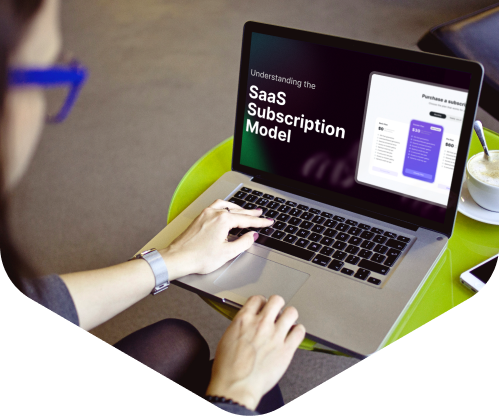Understanding the SaaS Subscription Model
Determining the right pricing model for your Software-as-a-Service (SaaS) product is a critical factor in determining your financial success.
Unfortunately, many SaaS software companies spend the least time on this.
The average SaaS startup only spends six hours on its pricing strategy, according to Cobloom.
Most SaaS companies rely on a subscription-based pricing and delivery model. This model allows customers to pay a set fee—either monthly or annually—to receive access to cloud-based software.
There are multiple types of subscription-based models you can use and many benefits that a subscription model can provide.
This article briefly outlines several of the most popular subscription types and explains why a subscription model could be a good solution for your SaaS company.
Types of SaaS Subscription Models
There isn’t a one-size-fits-all solution for SaaS subscription models, but there are several billing models that most SaaS companies more commonly use.
The financial and growth experts at Maxio and Cobloom have done a masterful job mapping and defining these models, so we’ll quickly reference them here.
Freemium
A popular software subscription model, the freemium pricing strategy provides users with a free version of the base product.
It allows users to use the product in a limited capacity, requiring them to upgrade to a paid subscription to unlock more features and functions.
While this can increase the adoption rate of your product and give users a taste of what they can expect, there’s no guarantee that free users will subscribe. As a result, this subscription-based pricing model could make it more costly to host the software over the long term.
Flat Rate
A relatively simple subscription-based pricing model, the flat-rate plan lets subscribers use the software for a set monthly or annual fee.
It’s helpful for customers to know and understand what they’re paying for and when, as well as for your company to have a rough idea of what to expect in revenue each month.
While it’s simple initially, it can also make it more challenging to adapt your pricing for businesses of various sizes, which could mean potential lost revenue, especially when selling to much larger organizations.
Usage Based
A usage-based software subscription model lets your customers pay for what they use. If they use more of the service, they pay more. If they use less, they pay less.
While this model can give customers confidence that they’re truly getting what they’re paying for, it’s more challenging to predict revenue. It can fluctuate greatly depending on your customer’s usage month to month.
Tiered
One of the more popular pricing models, the tiered plan, gives customers a fixed number of plans and prices to choose from.
Each plan tends to offer more features and benefits for the user while costing more per month or year.
Building tiers into your software subscription model gives customers more plans and pricing to choose from. Still, it can also become overwhelming when determining the best option or needing more flexibility for specific customers.
Per User
Another standard subscription-based pricing model bases costs on how many users can access the product.
This plan typically provides a fixed cost for a single user and increases as more and more users are added to the account.
While it’s straightforward and offers more predictability, it can become too expensive for some customers unless the cost becomes more advantageous as more users are added.
Benefits of a SaaS Subscription Model
While there are many types of subscription models to choose from, using the subscription-based pricing model provides a multitude of benefits for you and your customers.
The upsides of using a subscription SaaS model include the following:
- Cost-effective
- Scalability and flexibility
- Easy to update and maintain
- Accessible and convenient
- Lower barrier to entry
- Customer-centric approach
- Predictable revenue stream
Cost-Effective
Rather than paying a hefty upfront fee for traditional software licenses, customers can pay a regular subscription fee based on usage or the required features.
“Even with premium features added to a SaaS subscription plan,” says TechnologyAdvice’s Don Hall, “companies will save money because installing and maintaining software or business information technology (IT) assets is costlier than SaaS plans.”
This approach helps them manage their budget and allocate resources more efficiently.
Scalability and Flexibility
Depending on the model you opt for, customers can easily adjust their subscription SaaS plan, upgrade or downgrade the number of users, and access additional features or services as their business grows or requirements change.
This ensures that the product can align with the customer’s evolving needs and maintain scalability.
Easy to Update and Maintain
A subscription-based pricing model gives customers the advantage of ongoing improvements, bug fixes, and new features without users needing to handle updates independently. All they require is internet access.
This removes the pressure of infrastructure maintenance from your customers and enables them to concentrate on their primary business activities.
Accessible and Convenient
SaaS subscriptions enable access to the product from anywhere with an internet connection, making it convenient for users.
Customers can use the SaaS product on multiple devices and seamlessly access their data and applications.
This accessibility fosters productivity and collaboration, especially for distributed teams and remote work environments.
Lower Barrier to Entry
With no significant upfront investment, businesses can quickly adopt SaaS products and start using them immediately.
This reduces financial risks and allows businesses to explore and experiment with different SaaS offerings before committing to long-term contracts.
Subscription SaaS models such as freemium and tiered give users low-cost ways to ensure the product meets their needs before they commit more of their budget.
Customer-Centric Approach
Because customers pay for ongoing access and usage, you have a vested interest in delivering value and maintaining customer satisfaction.
Regular customer feedback and continuous improvement are essential for customer retention and success in the SaaS market.
Predictable Revenue Stream
The subscription model offers you a predictable and recurring revenue stream. Think of it like a SaaS membership.
“You already know exactly how much you will be bringing in each month since you are billing your customers on a recurring basis,” said consultant Ken Moo. “This predictability can help you better forecast your cash flow and plan for future expenses.”
The level of stability a subscription model provides allows for better financial planning, investment in product development, and long-term growth.
Investigate All the Options
Multiple factors determine which SaaS subscription model is best for your business.
Regardless of which pricing model you choose, take the time to thoroughly investigate all your options.
If you’re looking for a high-quality SaaS development company, our team at Taazaa has all the necessary roles and skill sets to build your product quickly and effectively.


